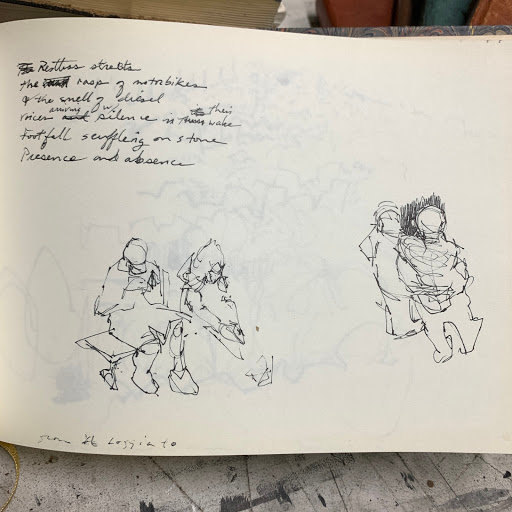A Painter's Notes
Remarks to students:
• See the serendipity in limitation. Work with what is possible within self-imposed limits.
• The rudiments of the pictorial language - a way to see beyond and beneath the apparent isolation of things.
• Realize what's at stake when you start dickering with what's in front of you, thinking that to do so is "creative." The total visual field with its web of relations and spatial markers, divisions, and tensions go out the window and all you're left with is a mental image of the objects and the Herculean task of relating them spatially by purely invented means. You don't want a collage of left-brain inventory markers. Sift, winnow and reduce by engaging with what's there, not by arrogantly ignoring it.
• Argument for painting that is about, involved with, inspired by, a visual-sensual experience, rather than a mental, notional, conceptually based experience. Why? The latter is our ordinary, everyday way of experiencing the world. It's thrice removed from the actual body experience. Sensation garbled by the mind and ego, regurgitated as symbols. Look for actual visual energy, the raw, uncensored "feeling" of color, light, shape, form, space.
• There is a "feng-shui" of painting - the pattern or flow of energy in and through a painting.
• Beware of the instant recognizibility of shapes. The idea of things (boats, bottles, eyes, e.g.) stays constant. A painting of boats is a painting of boats is a painting of boats. Approaching painting through your head fails to take into account that a given view, experience, or time of day, may not have any visual energy. It's merely a nice idea of a painting. We want it to have force and presence through particularities of form.
• Don't be a tourist when you paint. Paint the same thing repeatedly until you can begin to take some of the more obvious beauties for granted. Then you may start to find out what is personal, what speaks to your individual soul and sensibility, and find the way that you need to do the painting. This is what makes for originality, not some technique for its own sake.
• Make the time of day the subject of your painting. Make that the issue, rather than thinking of things as your subject. Deal with the quality of light that a two-hour period presents to you. See what happens. "Morning, 8:30 a.m." (Whatever the subject happens to be.)
• Think about your orientation to the sun as an issue rather than focusing totally on the fact that you want to paint a lobster boat. Stop borrowing on references to actual things to make your images interesting. Look for visual situations: color and shape dynamics, rhythms, repetitions, oppositions.
• Think about and enjoy the choices you make and try to witness how they bring about little revolutions in how you see, and what your eye experiences, and how this impacts upon your emotions. Painting is a perceptual process that takes place in time.
• The way the total space is interpreted, the observation of the instance, is what counts, not the things or the situations in themselves.
• When you draw a line in response to a thing before you, you address its existence, its reality, its nature, so be reverent, unassuming. Don't assume that the first line you draw is it. Probe. Ask questions with your lines. Nothing in life exists in itself. Everything is suspended in a web of relationships. Arrive at your drawing by studying, and searching out these correspondences.





Comments
Post a Comment